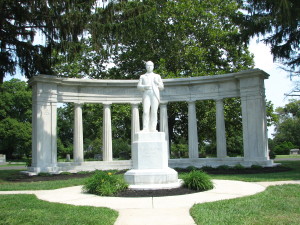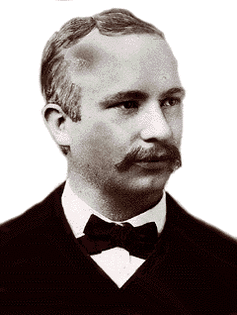The Father of Labor Day And His Pennsauken Monument
 By Robert Fisher-Hughes, AAP Columnist and Amateur Historian
By Robert Fisher-Hughes, AAP Columnist and Amateur Historian
In Arlington Cemetery in Pennsauken, N.J. there stands two monuments to Peter J. McGuire. The older of the two marks the resting place of the man and his family, but includes the inscription “Labor Omnia Vincit,” labor conquers all. When this monument was erected in 1906, any truth in that motto was largely due to the life’s work of the man so honored, and to a handful of his close colleagues in the labor movement.
Almost half a century later, the second and more elaborate monument was erected and dedicated to Peter J. McGuire, because the passage of years had solidified the historical significance of what he had accomplished for working men and women of America. For over one hundred years, this man’s presence has made Arlington Cemetery hallowed ground for American labor and the site of annual gatherings to commemorate the legacy of the Father of Labor Day, who also accomplished so much more.
Born in New York City in 1852, Peter J. McGuire grew up in the midst of rampant industrialization. From long working hours for low wages, to child labor and unsafe working conditions, the lack of collective bargaining and protective regulation made this an era of despair and struggle for American workers. Peter J. McGuire went to work at the age of 11 and became involved in the movement to organize workers for better conditions before he was 20. In his career, he founded one of the most powerful unions in America, the United Brotherhood of Carpenters and Joiners; led the fight for the eight hour workday; and was a founding officer of the American Federation of Labor.
McGuire’s most famous achievement, however, remains an idea he proposed in May 1882, at the New York Central Labor Union, for a day to be set aside to celebrate the American worker and to celebrate the achievements of the labor movement. He proposed the holiday be designated for the first Monday in September because no other existing holidays were near that date. In New York that September, the first Labor Day parade and celebration was held. Over time, the idea gained favor all over the country among working people. In 1894, when President Grover Cleveland signed the law declaring Labor Day as a national holiday, thirty states had already adopted the holiday themselves.
On Feb. 18, 1906, Peter J. McGuire died at the age of 54 at his home in Camden, N.J., worn out by his life of commitment to the struggle. His last words were that he had to hurry to help the boys in Local 122 in California, where there was trouble.
McGuire was interred at Calvary Cemetery in Delaware Township, now Cherry Hill. Soon after, however, his remains were moved to Arlington Cemetery in Pennsauken, when his widow, not Catholic, realized she could never rest at his side at Calvary. In the choice of his place of rest, as in his labor organizing, inclusiveness rather than division was most important.
A massive granite monument for Peter J. McGuire, as well as the cemetery lots and also provision for his widow, was supplied by the Local 8 of the United Brotherhood and the Central Labor Union of Camden. The national United Brotherhood also began a memorial fund drive to benefit the survivors of Peter McGuire, who had died almost penniless. The monumental stone, topped with a cross, also includes the emblem of the United Brotherhood of Carpenters and Joiners. It was carved by union men at M.C. Lyon’s Sons of Camden.
However, this could not be the end of Peter J. McGuire’s service and association with the cause. Starting in 1906 and each year since, groups of labor leaders, political VIPs, family and working people began gathering at the graveside at Labor Day. Here wreaths are laid, speeches are delivered in tribute, and a man and his great work are remembered.
Forty-six years later, the anniversary of Peter J. McGuire’s birth approached, and was remembered by the organizations he had helped found. 1952 was celebrated by the United Brotherhood of Carpenters and Joiners as the McGuire Centennial on a national scale. Issues of The Carpenter, the newspaper McGuire had started, now featured stories, pictures, and reminiscences of a leader who had been gone for decades.
At Arlington Cemetery, even as union membership and organizations grew in numbers and importance, the original monument to Peter J. McGuire came to be closely surrounded by other burials. It was time for a more fitting tribute to a man whose legacy and historical significance seemed to grow with each passing year. The United Brotherhood decided to install a new monument.
The new monument would include a central statue of McGuire, carved in Cherokee Georgia marble, embraced by a semi-circular colonnade of marble columns in the simple, Doric Greek style. The inscription on the colonnade states, “In Memory of Peter J. McGuire Founder of the U.B.C. and J. of A. and Father of Labor Day.”
On Aug. 9, 1952, the dedication ceremonies were held at Arlington Cemetery. Several thousand people attended, many of them ordinary union members. Among the dignitaries who spoke at the ceremony were the President of the New Jersey Federation of Labor; the mayors of Camden and Pennsauken; General President Hutcheson of the United Brotherhood of Carpenters and Joiners; the President of the A.F. of L., William Green; the secretary and treasurer of the A.F. of L., who later attained near legendary status himself, George Meany; and the U.S. Secretary of Labor, Maurice Tobin.
More honors and tributes to McGuire came in later years and continue to this day. Annual Labor Day commemorations have included congressmen and senators among others. In 1956, when a new postage stamp dedicated to American labor was issued at Labor Day, President Dwight Eisenhower held a special ceremony at the White House in which he met with family and descendants of Peter J. McGuire, including his great-granddaughter Jo Ann McGuire Dougherty of Pennsauken, N.J.
In 2004, Peter J. McGuire was admitted to the national Labor Hall of Fame of the U.S. Department of Labor, since renamed the Hall of Honor, which was established in 1988 and inducts only one figure annually.
Still, the most important tribute to McGuire is in the legacy of economic reforms to protect working people and in the enduring organizations fashioned to represent them and to carry on that work. That is why working people continue to visit this place.
Sources for this column and suggested further reading include: Back issues of The Carpenter available through The Internet Archive; Back issues of the Camden Evening Courier and the Courier Post; and “Public Sculpture in New Jersey: Monuments to Collective Identity;” Bzdak, Meredith Arms, Douglas Petersen, 1999.



